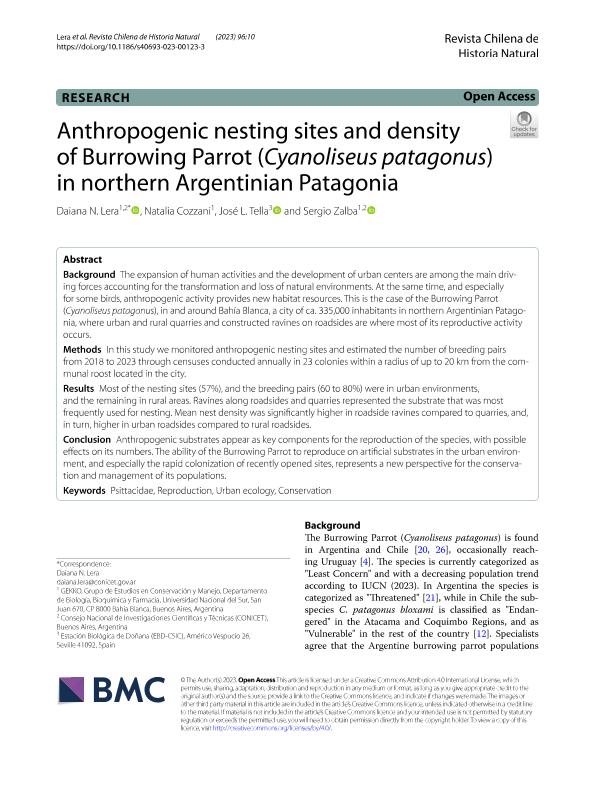Mostrar el registro sencillo del ítem
dc.contributor.author
Lera, Daiana Noelia

dc.contributor.author
Cozzani, Natalia Carolina

dc.contributor.author
Tella Escobedo, José Luis

dc.contributor.author
Zalba, Sergio Martín

dc.date.available
2024-01-09T14:10:47Z
dc.date.issued
2023-12
dc.identifier.citation
Lera, Daiana Noelia; Cozzani, Natalia Carolina; Tella Escobedo, José Luis; Zalba, Sergio Martín; Anthropogenic nesting sites and density of Burrowing Parrot (Cyanoliseus patagonus) in northern Argentinian Patagonia; Sociedad de Biología de Chile; Revista Chilena de Historia Natural; 96; 1; 12-2023; 1-9
dc.identifier.issn
0716-078X
dc.identifier.uri
http://hdl.handle.net/11336/223040
dc.description.abstract
Background: The expansion of human activities and the development of urban centers are among the main driving forces accounting for the transformation and loss of natural environments. At the same time, and especially for some birds, anthropogenic activity provides new habitat resources. This is the case of the Burrowing Parrot (Cyanoliseus patagonus), in and around Bahía Blanca, a city of ca. 335,000 inhabitants in northern Argentinian Patagonia, where urban and rural quarries and constructed ravines on roadsides are where most of its reproductive activity occurs. Methods: In this study we monitored anthropogenic nesting sites and estimated the number of breeding pairs from 2018 to 2023 through censuses conducted annually in 23 colonies within a radius of up to 20 km from the communal roost located in the city. Results: Most of the nesting sites (57%), and the breeding pairs (60 to 80%) were in urban environments, and the remaining in rural areas. Ravines along roadsides and quarries represented the substrate that was most frequently used for nesting. Mean nest density was significantly higher in roadside ravines compared to quarries, and, in turn, higher in urban roadsides compared to rural roadsides. Conclusion: Anthropogenic substrates appear as key components for the reproduction of the species, with possible effects on its numbers. The ability of the Burrowing Parrot to reproduce on artificial substrates in the urban environment, and especially the rapid colonization of recently opened sites, represents a new perspective for the conservation and management of its populations.
dc.format
application/pdf
dc.language.iso
eng
dc.publisher
Sociedad de Biología de Chile

dc.rights
info:eu-repo/semantics/openAccess
dc.rights.uri
https://creativecommons.org/licenses/by/2.5/ar/
dc.subject
CONSERVATION
dc.subject
PSITTACIDAE
dc.subject
REPRODUCTION
dc.subject
URBAN ECOLOGY
dc.subject.classification
Ecología

dc.subject.classification
Ciencias Biológicas

dc.subject.classification
CIENCIAS NATURALES Y EXACTAS

dc.title
Anthropogenic nesting sites and density of Burrowing Parrot (Cyanoliseus patagonus) in northern Argentinian Patagonia
dc.type
info:eu-repo/semantics/article
dc.type
info:ar-repo/semantics/artículo
dc.type
info:eu-repo/semantics/publishedVersion
dc.date.updated
2024-01-09T10:07:38Z
dc.identifier.eissn
0717-6317
dc.journal.volume
96
dc.journal.number
1
dc.journal.pagination
1-9
dc.journal.pais
Chile

dc.journal.ciudad
Santiago de Chile
dc.description.fil
Fil: Lera, Daiana Noelia. Universidad Nacional del Sur. Departamento de Biología, Bioquímica y Farmacia; Argentina. Consejo Nacional de Investigaciones Científicas y Técnicas. Centro Científico Tecnológico Conicet - Bahía Blanca; Argentina
dc.description.fil
Fil: Cozzani, Natalia Carolina. Consejo Nacional de Investigaciones Científicas y Técnicas. Centro Científico Tecnológico Conicet - Bahía Blanca; Argentina. Universidad Nacional del Sur. Departamento de Biología, Bioquímica y Farmacia; Argentina
dc.description.fil
Fil: Tella Escobedo, José Luis. Consejo Superior de Investigaciones Científicas. Estación Biológica de Doñana; España
dc.description.fil
Fil: Zalba, Sergio Martín. Consejo Nacional de Investigaciones Científicas y Técnicas. Centro Científico Tecnológico Conicet - Bahía Blanca; Argentina. Universidad Nacional del Sur. Departamento de Biología, Bioquímica y Farmacia; Argentina
dc.journal.title
Revista Chilena de Historia Natural

dc.relation.alternativeid
info:eu-repo/semantics/altIdentifier/doi/http://dx.doi.org/10.1186/s40693-023-00123-3
dc.relation.alternativeid
info:eu-repo/semantics/altIdentifier/url/https://revchilhistnat.biomedcentral.com/articles/10.1186/s40693-023-00123-3
Archivos asociados
